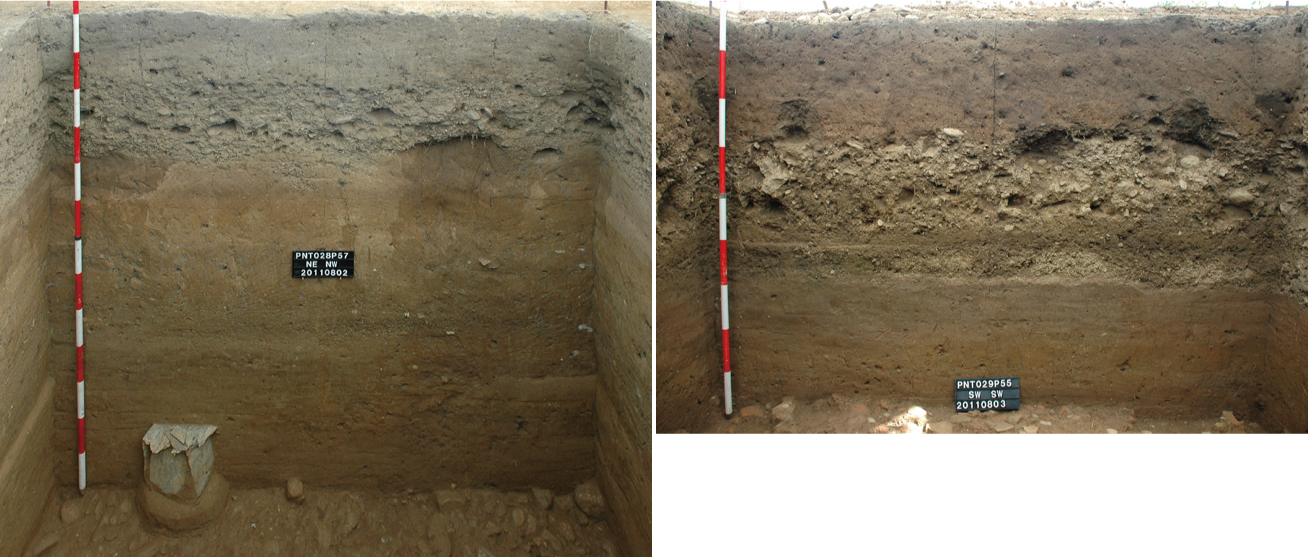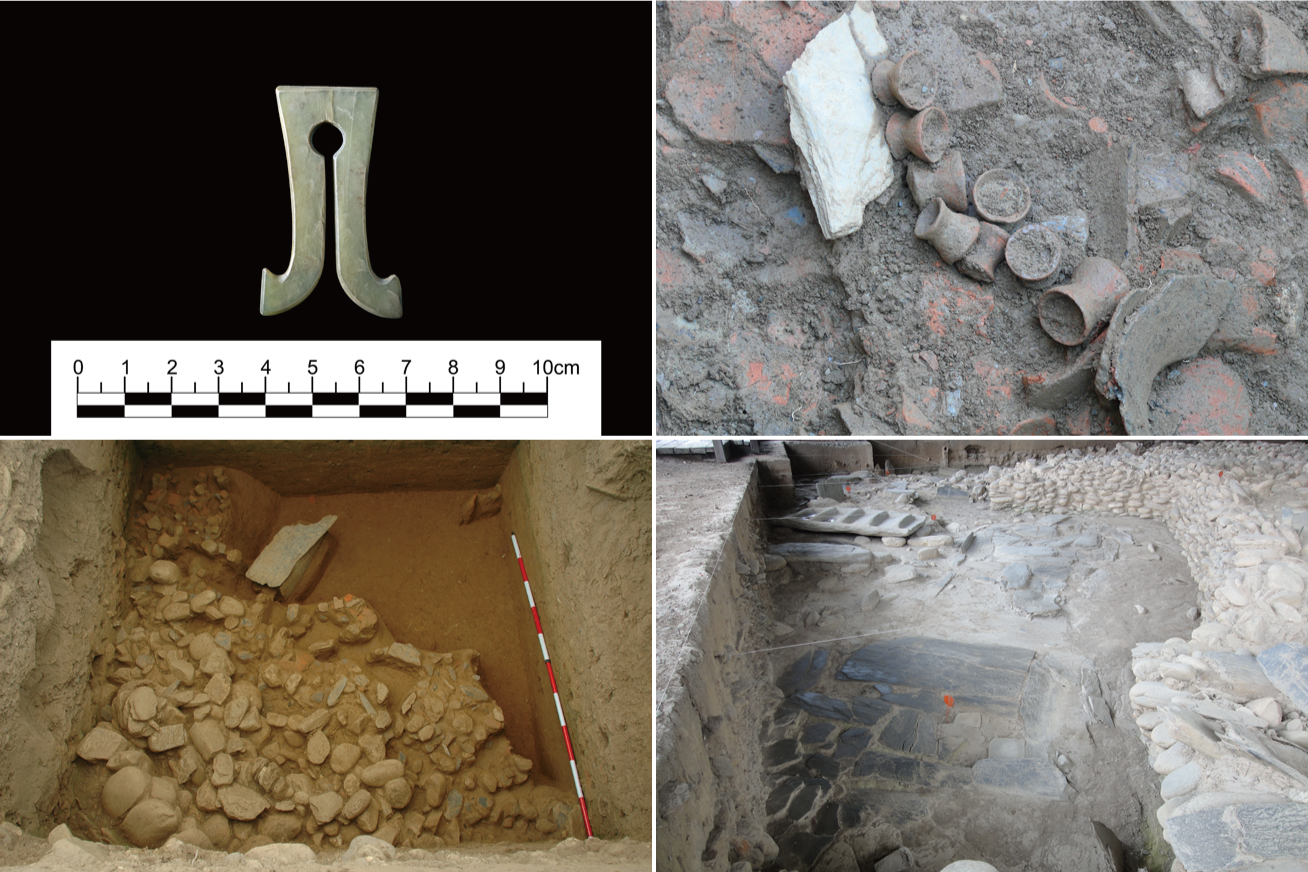:::
General Information of the Site
From the historical excavation data at the Peinan
Site, we can see that the Peinan Site was preserved primarily in three layers
of the soil, which were the outermost terrestrial washed topsoil, the
intermediate river washed loess layer and the bottommost gravel layer and also
the old riverbed. The upper edges of the loess and gravel layers were the
strata where the pre-history cultural level was formed. The pre-history
cultural level can be further divided to the “Rope Figure Pottery Cultural
Level,” “Peinan Cultural Level,” and “Sanhe Cultural Level” based on the timing
of their formation. Descriptions of the respective levels are given below:
I. Peinan Cultural Level
“The light brown soil layer underneath topsoil houses
dense ceramic sheets, remains of stone tools, and building traces primarily
consisting of slates and gravels. The thickness varies widely between 30 and
100cm. This layer is even thicker in the southern part of the excavation site.
It is generally 100cm but areas with a “trash pit” can be as thick as 160cm
(Chiang Wang, 1984:33). This layer houses remains that disclose the
contemporary daily activities and acts of people of the Peinan Culture during
their occupation, i.e. the archeological remnants and house relics or burned
areas, among other accumulations of remains that tell us about the contemporary
“phenomena.” But in fact, the activities of the people of the Peinan Culture
were not limited to the contemporary ground surface and encompassed digging
underground to bury the dead. In other words, the life and living of the people
of the Peinan Culture would not go beyond the lower end of this light brown
soil layer and the dense slate coffins on top of the light yellow soil layer
and the gravel layer underneath are the burial remains of the Peinan Culture
and should be part of the Peinan Cultural Level.” (Chao-Mei Lien & Wen-Hsun
Sung, 2004:46-47)


II. Rope Figure Pottery Cultural Level
“Between the light brown layer and the gravel layer
were sporadic translucent objects consisting of fine sand or loess or tiny
gravels plus loess…Among the intermediate layer of translucent objects, besides
ceramic sheets of the Peinan Culture, ceramic specimens with textures, shapes,
and figures different from those in the upper Peinan Cultural Level were found.
The ceramic pieces uncovered in the intermediate layer of translucent objects
featured rope figures. Therefore, it was referred to as the Rope Figure Pottery
Cultural Level to differentiate from the Peinan Cultural Level.” (Quoted above:
47)

III. Sanhe Cultural Level
Besides discovery of the New Stone Age Culture at the
Peinan Site, it was recorded in literature of earlier excavations that iron
tools were earthed (Kaneseki Takeo & Kokubu Naoichi, 1990:147, translated
by Chi-Shan Tan). However, it was not until recent years when archaeological
excavations were performed on the archeological site and in the area eastern to
the railway that more specific remnants from the Iron Age were unearthed.
Remnants that were uncovered included iron spearheads, iron ingots, glass beads
and triangle handles, etc. (Kun-Hsiu Li, 2002; Mei-Chen Yeh, 2006)
KunHsiu Li (2002:69) asserted that the Iron Tool Cultural Level found at the
Peinan Site should be referred to as the “Sanhe Culture”. The discovery of this
cultural level not only confirmed that it was directly related to the Peinan
Culture but also pulled the subsequent development of the Peinan Culture from
the previously thought northern side of the Peinan River back to the Peinan
Plain.
Chronological data on the Peinan Site were mainly
based on the data uncovered during multiple excavations. By far, there have
been chronological data on the carbon 14 dating performed on wooden charcoal
and human bones and the thermoluminescent dating performed on ceramic pieces
(Table 1-4). From the chronological data unearthed during archaeological
excavations between 1980 and 1988, Wen-Hsun Sung and ChaoMei Lien (1988:56)
believed that “seven pooled chronological data from 2800B.P. to 3400B.P. were
very credible indications of the Peinan Cultural Age. However, this period of
time seems to be insufficient to represent the whole duration of the Peinan
Culture. Therefore, terminal data from the oldest year 5300B.P and the latest
year 2033B.P. need further discussions.” However, later earthed data showed
that between 2300B.P and 1900B.P., the Peinan Site should belong to the “Sanhe
Culture” of the Iron Age (Kun-Hsiu Li, 2002: 66).
